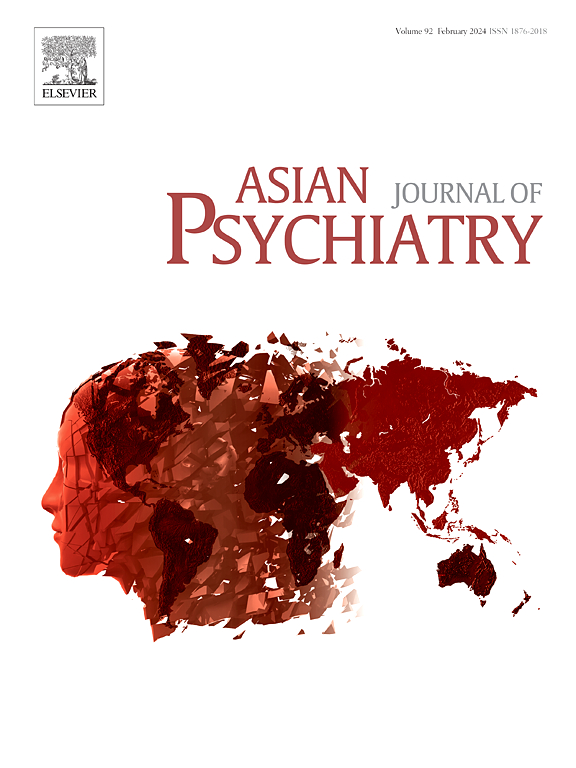基于连接体预测模型的脑功能网络预测精神分裂症的不同症状:一项多位点fMRI研究
IF 4.5
4区 医学
Q1 PSYCHIATRY
引用次数: 0
摘要
先前关于精神分裂症(SCZ)患者不同症状的脑功能改变的研究结果不一致。小样本量可能导致这种不一致。为了克服这一局限性,我们进行了一项多地点研究,以探索SCZ不同症状的神经机制。这项多站点研究包括来自3个站点的4个数据集,包括258名SCZ患者和222名健康对照。采用基于阳性和阴性症状量表(PANSS)的四因素模型识别SCZ的四个症状维度:阴性、阳性、情绪和认知症状。基于连接体的预测建模(CPM)和基于节点的网络分析。然后,使用支持向量机对SCZ患者和hc进行分类。CPM模型可以成功预测SCZ患者的阴性、阳性、情感和认知症状,相关系数为- 0.339至- 0.057。阴性和情感症状预测模型通过两个独立的SCZ队列进行验证。大多数预测边缘连接在运动/感觉(Mot)、额顶叶、默认模式、显著性和其他网络之间。Mot网络参与了CPM模型的所有症状维度。在预测边缘中,与hc相比,3条边缘的FC增加,6条边缘的FC减少。这些异常的fc可以区分患者和hcc,准确率为91.2 %。预测网络主要涉及感觉加工和高级认知,这可能是SCZ的功能基础。Mot网络可以作为跨所有症状维度的关键枢纽。本文章由计算机程序翻译,如有差异,请以英文原文为准。
Functional brain networks predicting different symptoms of schizophrenia based on connectome-based predictive modeling: A multi-site fMRI study
Previous findings on brain functional alterations across different symptoms of schizophrenia (SCZ) patients had yielded inconsistent results. Small sample sizes could contribute to this inconsistency. To overcome this limitation, we conducted a multi-site study to explore the neural mechanisms underlying different symptoms in SCZ. This multi-site study included four datasets from three sites, comprising 258 SCZ patients and 222 healthy controls. A four-factor model based on the Positive and Negative Syndrome Scale (PANSS) was applied to identify four symptom dimensions of SCZ: negative, positive, emotional, and cognitive symptoms. Connectome-based predictive modeling (CPM) and node-based network analysis were conducted. Then, the support vector machine was used to classify SCZ patients and HCs. CPM models could successfully predict negative, positive, affective, and cognitive symptoms in SCZ patients, with correlation coefficients ranging from −0.339 to −0.057. Models for negative and affective symptom prediction were validated by two independent SCZ cohorts. Most predictive edges were connected between the Motor/Sensory (Mot), Fronto-Parietal, Default Mode, Salience, and other networks. The Mot network was involved in the CPM models across all symptom dimensions. Of the predictive edges, three edges exhibited increased FC, while six ones demonstrated decreased FC compared to HCs. These abnormal FCs could classify patients and HCs with an accuracy of 91.2 %. The predictive networks were primarily involved in sensory processing and high-level cognition, which could be a functional basis of SCZ. The Mot network may serve as a key hub across all symptom dimensions.
求助全文
通过发布文献求助,成功后即可免费获取论文全文。
去求助
来源期刊

Asian journal of psychiatry
Medicine-Psychiatry and Mental Health
CiteScore
12.70
自引率
5.30%
发文量
297
审稿时长
35 days
期刊介绍:
The Asian Journal of Psychiatry serves as a comprehensive resource for psychiatrists, mental health clinicians, neurologists, physicians, mental health students, and policymakers. Its goal is to facilitate the exchange of research findings and clinical practices between Asia and the global community. The journal focuses on psychiatric research relevant to Asia, covering preclinical, clinical, service system, and policy development topics. It also highlights the socio-cultural diversity of the region in relation to mental health.
 求助内容:
求助内容: 应助结果提醒方式:
应助结果提醒方式:


